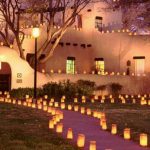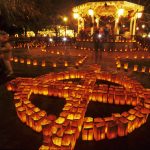Divinity 1955
An aspect of divinity – the heavenly marshmallow-like white fudge candy my father always cooked up around Christmas time – is that it is very susceptible to changes in humidity and can sometimes flummox even those who have made it a hundred times. When it’s right, it’s indeed divine. One year in the mid-50’s – I would have been six or seven, in Albuquerque, where I grew up – it was snowing on Christmas Eve and crazy cold, and my dad’s divinity failed! It had something to do with the snow or the humidity or perhaps his rush to ignore the stern guidance of a candy thermometer which insisted on registering an exact hard ball candy temperature of 260-degrees before folding the scalding stovetop mix of sugar and corn syrup into stiff-beaten eggs with a dash of vanilla and a pinch of salt and not much else. Simple recipe, simple directions; yet, this time the goop would not abide and never turned into the heavenly white fudge we loved only at Christmas. To err is human; to forgive, well, divine. Christmas survived but it was off to a rocky start.
The final few school days before Christmas vacation were always absolute agony – one could barely wait for the two-week parole. Some of us found a way to fill the days with a particularly Albuquerque brand of fun; on rare snowy days after several hours of building snow forts and snow beasts, we ventured on foot into the white glazed streets where cautious drivers had packed the snow into a frozen layer which improved with use.
With the temperature well below freezing, the method was this: a well-bundled kid would venture off the sidewalk as a car approached (doing maybe six miles an hour), at the appropriate instant the kid would crouch down, grab the rear  fender, hold on for dear life and ride that unsuspecting car or truck sometimes for blocks. We called it “skitching” for skating/skiing and hitching, as in hitchhiking. Did other kids in Philadelphia or Buffalo or Butte discover the same thing at about the same time? Probably. Still, it was ours on certain magical days and we smoothed the rules into these: In order to slide effectively you had to wear hard sole shoes or boots, sneakers just wouldn’t do; our tribe sought world records–four or five young fools on a bumper was outstanding; distance and endurance counted for everything, a half-block “skitch” was hardly worth doing, a twenty-block excursion was superb; the last kid to grab on invariably got the exhaust pipe in his face and usually lasted less than a block.
fender, hold on for dear life and ride that unsuspecting car or truck sometimes for blocks. We called it “skitching” for skating/skiing and hitching, as in hitchhiking. Did other kids in Philadelphia or Buffalo or Butte discover the same thing at about the same time? Probably. Still, it was ours on certain magical days and we smoothed the rules into these: In order to slide effectively you had to wear hard sole shoes or boots, sneakers just wouldn’t do; our tribe sought world records–four or five young fools on a bumper was outstanding; distance and endurance counted for everything, a half-block “skitch” was hardly worth doing, a twenty-block excursion was superb; the last kid to grab on invariably got the exhaust pipe in his face and usually lasted less than a block.
 Luminarias, or more properly, favolitos, were another New Mexico tradition my father insisted upon. Ours involved several days of planning and prep before installation day, which most years was the day after Thanksgiving. “Black Friday” hadn’t been dreamed up yet, back then most of the stores were closed until the following Monday. People were busy stringing a few colorful Christmas lights from the eves or carefully filling brown paper bags with an inch and a half of sand in the bottom and a small votive candle in the center. The bags were set out two feet apart to line the boundaries along sidewalks, fences, driveways, porches and porticoes, and rooftops.
Luminarias, or more properly, favolitos, were another New Mexico tradition my father insisted upon. Ours involved several days of planning and prep before installation day, which most years was the day after Thanksgiving. “Black Friday” hadn’t been dreamed up yet, back then most of the stores were closed until the following Monday. People were busy stringing a few colorful Christmas lights from the eves or carefully filling brown paper bags with an inch and a half of sand in the bottom and a small votive candle in the center. The bags were set out two feet apart to line the boundaries along sidewalks, fences, driveways, porches and porticoes, and rooftops.
For spectacular Christmas lighting displays, Ridgecrest Drive was the place to go. Some of the mansions were revered year after year, far and wide, for their audacious displays of multi-colored lights – all incandescent of course, LEDs were years away – many with movable displays of home-made Santas, reindeer, elves, candy canes and sugar plumbs.
At dusk each evening we would venture out to fire up those little candles along our driveway, sometimes hundreds of them, each flimsy bag adding its warm glow to the overall effect.

Just as luminarias reminded us of the season, so too did the aromas of our Decembers . We followed our noses into autumn with chili roasting in the open air in September (very New Mexican) followed by traditional turkey at Thanksgiving, empanadas baking alongside potica or brioche or focaccia, the clean pine smell of a fresh-cut Christmas tree, mulled wine or warm cocoa, the remarkably redolent whiff of piñon pine incense in church or outside in the chattering cold air decorated with the faintest hint of sweet smoke from an unseen pile of burning leaves or someone’s hearth fire. The fragrance of Christmas in New Mexico is without question or debate the sweet, delicate smoke of the piñon pine.
Yes, I remember the stark disappointment of that failed batch of divinity as if it were last night – Christmas Eve without divinity was almost too much for a seven-year-old to bear – for about five minutes. Then, because there was always and ever present the giddy anticipation of what might show up under the tree in just a few hours, disappointment gave way to hope. Funny, it’s impossible to recall most of the toys wished-for and received all those six decades ago but the pungent and poignant reminders childhood Christmases live on.
One of the insults of Parkinson’s disease is the loss of the sense of smell and with it, taste. Yet, as Proust reminds us, memories engraved by taste and scent endure and are yet again more redolent than the event itself. There were many happy events at our house in Albuquerque and many successful batches of white fudge whipped up by my dad, always and only at Christmas time. Divine!
